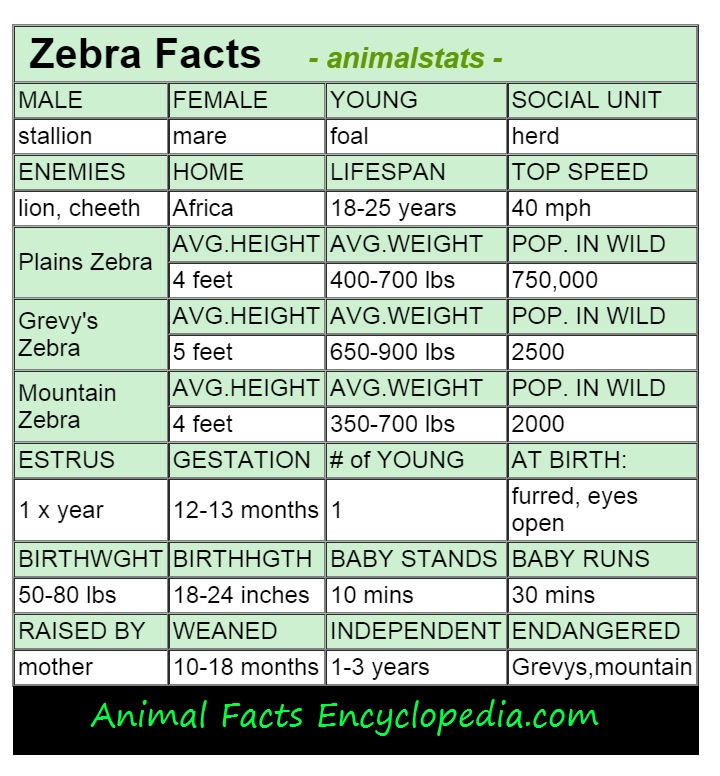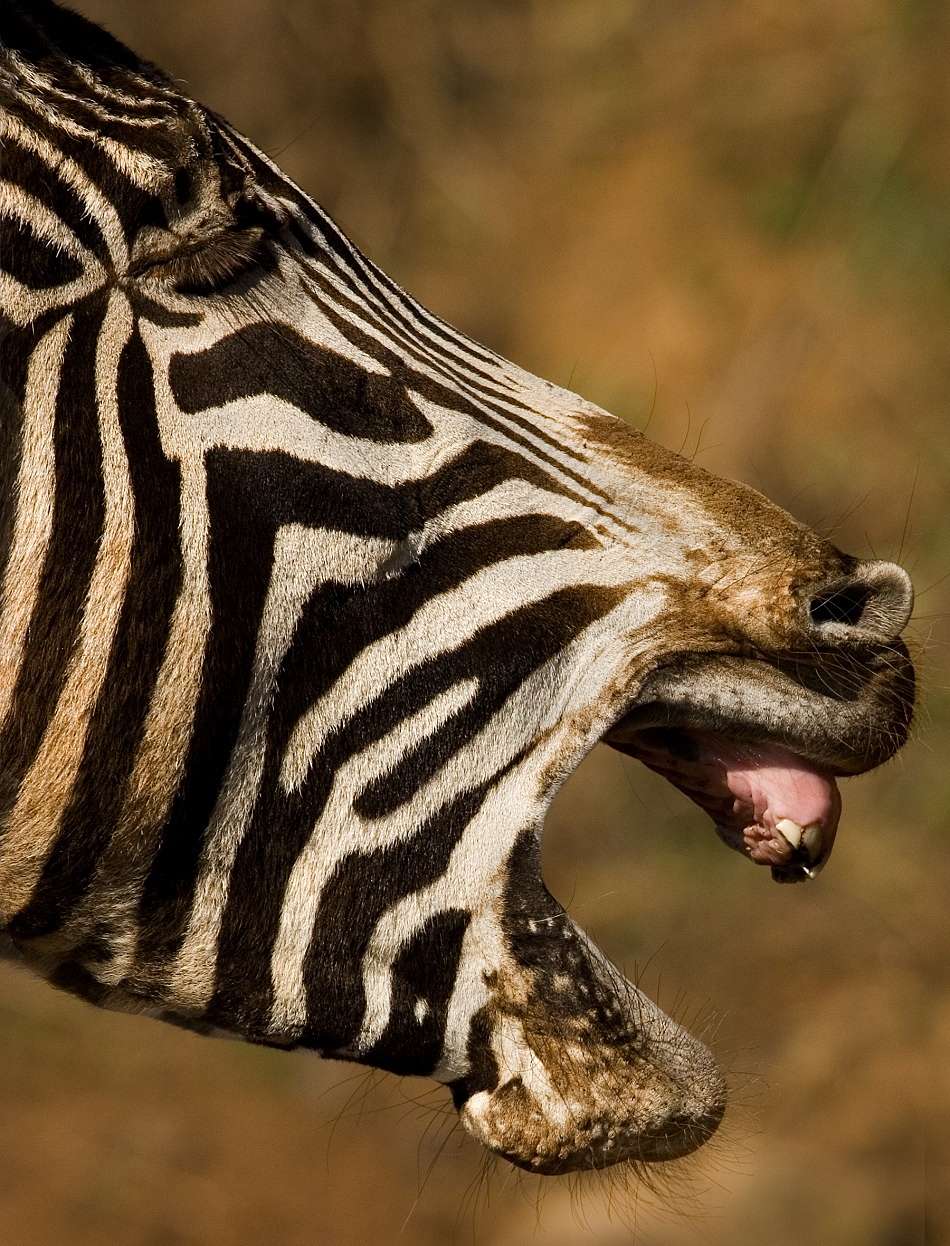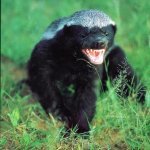zebra Facts
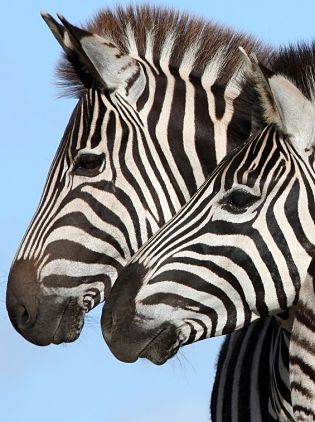
A glorious fixture of the African landscape, the zebra is a very flashy member of the normally mousy-colored horse family. Sporting a robust body of bold stripes, the zebra spends its busy life on the move seeking the best grazing in the mostly dusty world of the African savanna.
Because its skin is dark, many experts suggest that the zebra is a black (sometimes brown) furred animal with white stripes, while others will argue that the zebra has black stripes on a white field, pointing out the animals white undersides.
No matter, the effect is dazzling, and provides this gregarious herd animal with a confusing defense of fluctuating dark and light motion. When a group of zebras rumbles passed a lion, leopard or cheetah, it is virtually impossible for the predator to pick out just one individual target. For the zebra, as is the case with many herd animals, there is great security in numbers.
There are 3 main species of zebra. The most familiar are the plains zebras of which there are 5 subspecies each with slight variations in not only stripe pattern but color as well, some being decidedly brown instead of black. Of these, the Grant's, a hearty animal true, bold black and white stripes that grow wider as they reach the rump, is the classic zebra in type.
Although there are some more populous sub-species, and interbreeding occurs, the Grants remains one of the most iconic sights on the African plains. The mountain zebras consist of 2 subspecies most easily distinguished by the fishbone pattern across the top of the rump. Mountain zebras also have a dewlap - a flap of loose skin at the throat, the function of which is unclear.
Finally, the Grevy's zebra is in its own sub genus and is more donkey-like. It has thinner more numerous, and closely spaced stripes, often brown in color.
All the zebra species are herd animals, highly social and dependent on the camouflaging effect of a mass of striped bodies for survival. Constantly moving, always alert for danger, zebras have surprisingly good eyesight, and it is believed that, despite being monochrome themselves, they actually see the world around them in full color. - Zebra Facts
Why does a zebra have stripes?
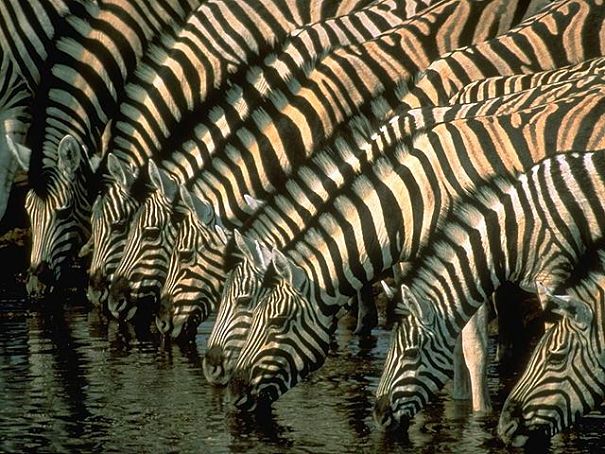
Even at the edge of a watering hole there is danger, but zebras love a crowd. The herd instinct draws them together, the exquisite skin often keeps them in one piece in more ways than one.
Imagine a crouching lion or hidden crocodile trying to select just one target in a dazzling sea of stripes. For well-camouflaged animals such as the zebra, it is more often movement and not the outline of a form that attracts the predator to an individual. A stilted gait, the bobbing head that comes with a lame leg, a stumble, a hesitation, the curtain of healthy companions rush away and the target is revealed.
But despite being every bodies favorite meal, the plains zebra is an extraordinarily successful animal, and though nature channels are rife with scenes of tragic endings, the majority of zebras lead long lives of 15 to 20 years. Even with territories dwindling as human-kind encroaches, the plains zebra herds are over 3/4 of a million animals strong. - Zebra Facts
zebra reproduction
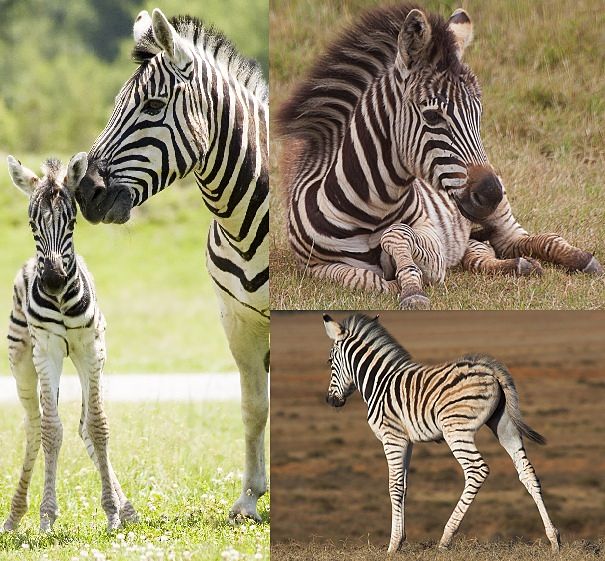 Zebra mothers and foals
Zebra mothers and foals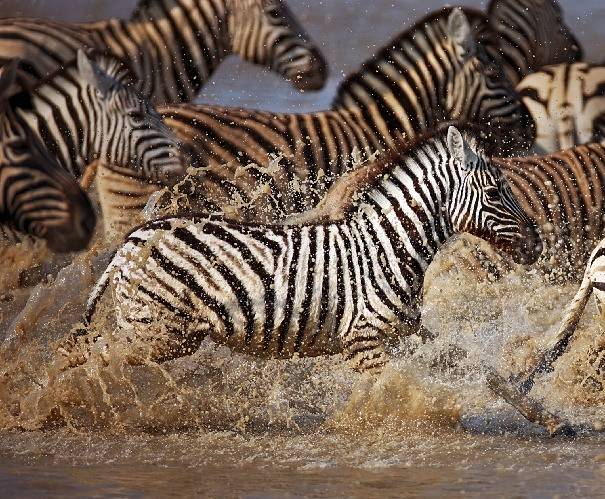
The very social zebra requires the safety and comfort of a herd to survive. Two types of zebra herds exist, one being made up of a "harem" of females and their foals escorted by 1 stallion, the other being a "bachelor herd" of males who are either too young, too old, or too timid to gather a harem of their own.
Stallions are males at least 5 years of age who have fought with other males for the right to accompany and mate with the females in the harem. The females have a hierarchy and will often walk in line in the order in which they joined the group.
The senior mare will make most of the decisions for the herd, leading them to pastures and watering holes. The stallion will bring up the rear or patrol the flanks on the lookout for predators and other males who might steal his mares away.
Pregnancy lasts for a year and the newborn struggles to its feet in a matter of minutes. The skull of a newborn zebra is less than 1/2 the length of its mothers, but the babies legs are 95% the length of hers.
Speed really matters in the perilous world of a baby zebra and within moments of birth the infant is on its feet and ready to run, keeping to the center of the herd as much as possible and dodging the large hungry jaws of cheetahs, hyenas, lions and crocodiles on a daily basis. The mother does the parenting and will nurse the foal for up to 18 months.
Young males will leave the herd at between 1 and 2 years of age to join a herd of bachelors. Likewise, young females will leave when they come into their first estrus joining with a new dominant male who has chased away all suitors.
Because both the males and the females leave their original herd, the harems that are formed are actually groups of unrelated females who form strong bonds and live together as a family, usually their entire adult lives. - Zebra Facts

fight club and the "super herd"
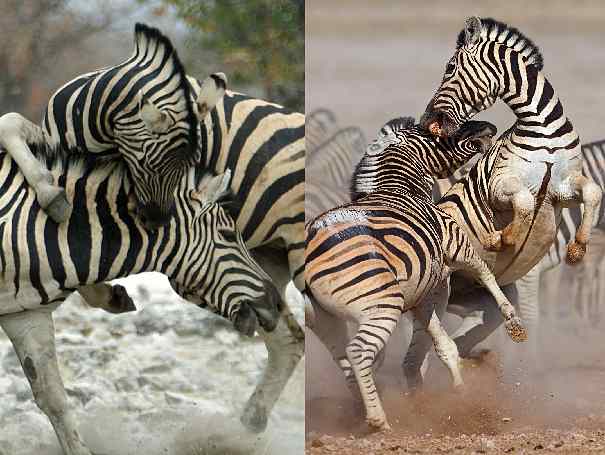
In some regions where populations are large, the plains zebras social structure can be rather complex.
Multiple stallions with their harems and youngsters in tow, will come together to form a "super herd" of up to 300 individuals. When a bachelor herd approaches a "super herd" the stallions greet them as a unit and work together to fight them off.
When the battles are over the stallions will return to their own harems. Within the "super herd" the harem structure remains intact with each mare remaining devoted to only her stallion, and each stallion keeping to his own mares. - Zebra Facts
zebra identification guide - a tale of some tushies
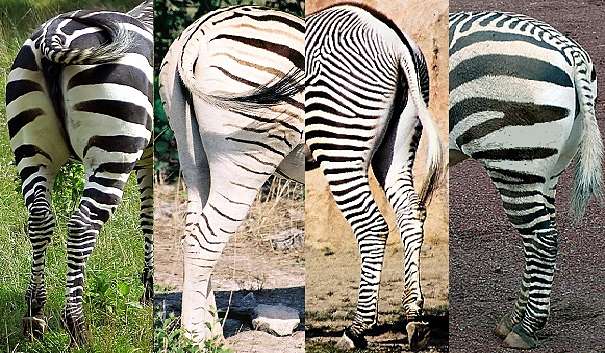

Look to the rear when trying to identify a zebra species or subspecies.
Our first example is the broad black stripes of the famous Grant's zebra (the rare Selous zebra is similar).
Second: The 2-toned "shadow" stripes, and sometimes stripe- less legs of the Burchell's. (the Chapman's and Crawshay's zebras are similar)
Third: The Grevy's has narrow, close-set, often brown lines, a prominent dorsal stripe with white outline and plush dark dorsal hair. The stripes do not go under the belly.
Fourth: The "fish bone", or "gridiron" pattern across the top of the rump of the mountain zebra. The mountain zebra tends to have the biggest variation in stripe width across the body (see small inset photo) with narrow, close-set stripes on the ribs changing abruptly to broad, wide-set stripes on the sides of the buttocks. Stripes do not go under the belly. Without a top view you can usually still identify the mountain zebra from the side- look for the tips of the fish bones! -Zebra Fact
which zebra is this?
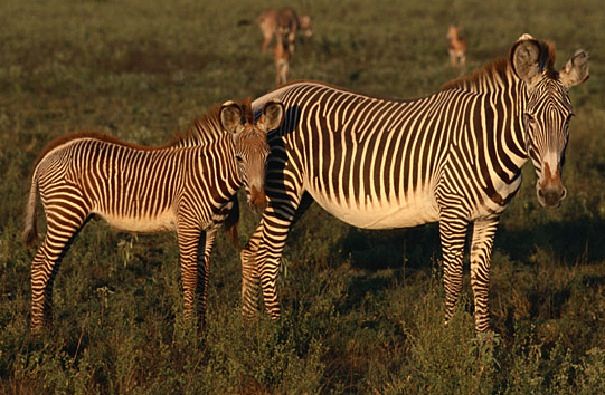
So which zebra species is the mother/son duo in the photo to the left? Yes! - A Grevy's zebra mare and foal.
grant's zebra
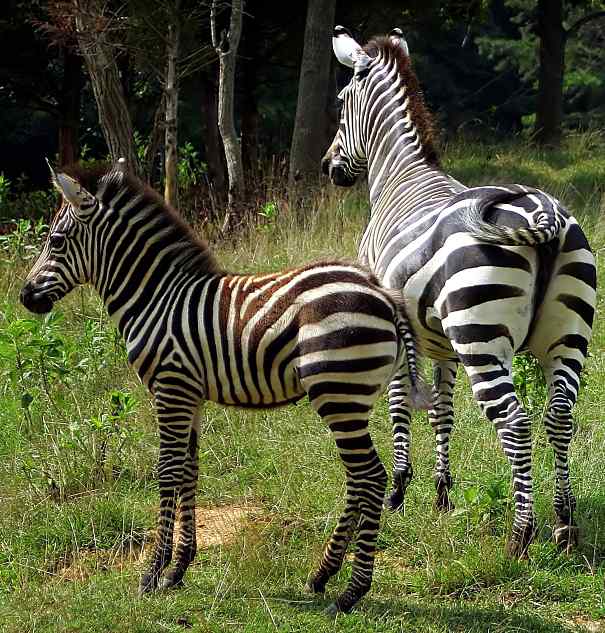
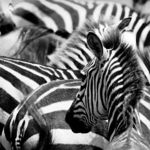

Beefy build, thick neck, big, broad, black stripes it is the Grant's zebra. A mother and baby Grant's zebra in glorious black and white! Just look at the length of that foals legs - baby you were born to run!.
Burchell's zebra
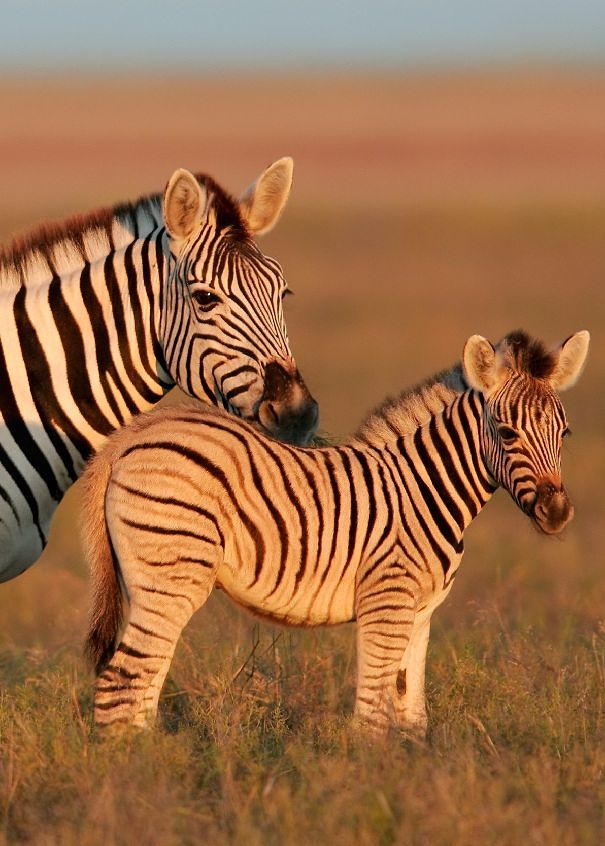
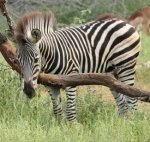
If the zebra has the Grant's sturdy build, but thinner two-toned stripes it is one of three subspecies. The Burchell's zebra, the Chapman's zebra and the Crawshay's zebras occasionally inter-breed and make positive identification tricky, but of the three, the Burchell's is the most common. In fact, the Burchell's is the most populous of all the zebra species. This is most likely a Burchell's zebra mare and foal. - Zebra Facts!
a few more zebra facts
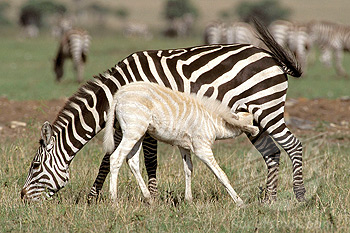
- Contrary to some claims, zebras, like all other equines, identify each other by smell and vocalization, not by their stripes.
- The zebras stripes make it more difficult for predators to target one individual out of the herd.
- Albino zebras occasionally occur in the wild. Often called "golden zebras" they are not true albinos, but have pale tan or golden stripes and light brown or even blue eyes.
Scientific Classification:
| Zebra Facts - animalstats - | |||
|---|---|---|---|
| MALE | FEMALE | YOUNG | SOCIAL UNIT |
| stallion | mare | foal | herd |
| ENEMIES | HOME | LIFESPAN | TOP SPEED |
| lion, cheeth | Africa | 18-25 years | 40 mph |
| Plains Zebra | AVG.HEIGHT | AVG.WEIGHT | POP. IN WILD |
| 4 feet | 400-700 lbs | 750,000 | |
| Grevy's Zebra | AVG.HEIGHT | AVG.WEIGHT | POP. IN WILD |
| 5 feet | 650-900 lbs | 2500 | |
| Mountain Zebra | AVG.HEIGHT | AVG.WEIGHT | POP. IN WILD |
| 4 feet | 350-700 lbs | 2000 | |
| ESTRUS | GESTATION | # of YOUNG | AT BIRTH: |
| 1 x year | 12-13 months | 1 | furred, eyes open |
| BIRTHWGHT | BIRTHHGTH | BABY STANDS | BABY RUNS |
| 50-80 lbs | 18-24 inches | 10 mins | 30 mins |
| RAISED BY | WEANED | INDEPENDENT | ENDANGERED |
| mother | 10-18 months | 1-3 years | Grevys,mountain |
see more animal extreme closeups
Recent Articles
-
African Animals - Animal Facts Encyclopedia
Oct 11, 16 10:27 PM
African Animals facts photos and videos..Africa is a wonderland for animal lovers, and a schoolroom for anyone who wants to learn about nature, beauty and the rhythm of life -
Baboon Facts - Animal Facts Encyclopedia
Oct 11, 16 10:26 PM
Baboon facts, photos, videos and information - Baboons are very distinctive looking monkeys with long, dog-like snouts and close set eyes. -
Great Apes Facts - Animal Facts Encyclopedia
Oct 11, 16 10:25 PM
Great apes facts, photos and videos..Human beings did not evolve from chimpanzees, modern chimps and gorillas do not appear in the fossil records until much more recently than homo sapiens..
